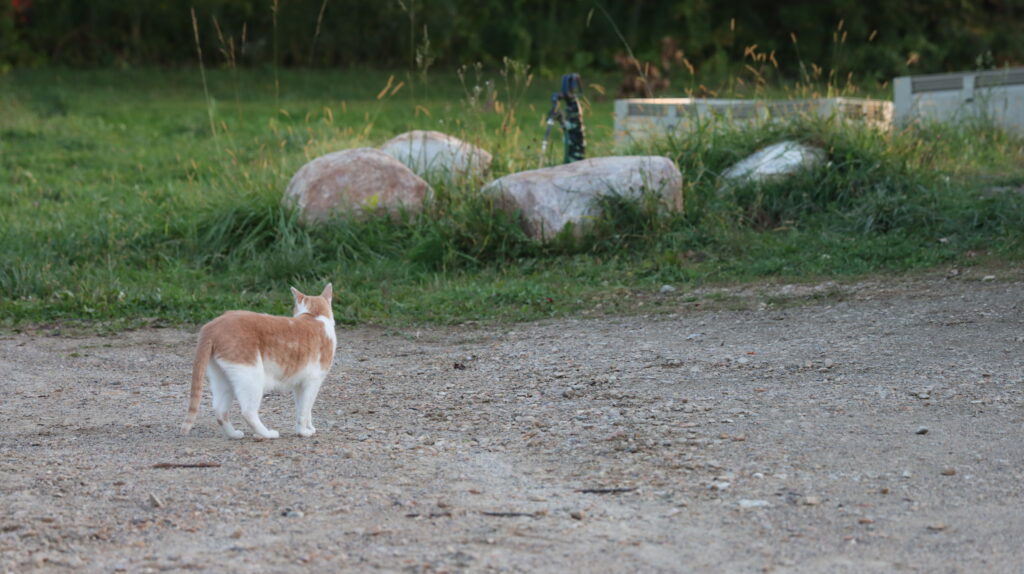Authored by Phil Tocco, Michigan State University & Chris Callahan, University of Vermont

View or download a PDF of this factsheet here.
Many small farmers rely on cats to control rodents on farms. These “working animals” seem like a good way to limit crop loss and reduce other produce safety risks from rodents. Unfortunately, cats bring risks of their own. Cats are the only full-cycle host of a protozoan parasite called Toxoplasma gondii (T. gondii or ‘toxo’).

The FSMA Produce Safety Rule generally requires “measures reasonably necessary to prevent the introduction of known or reasonably foreseeable hazards into covered produce” (112.11). The rule specifically requires an assessment of areas where covered activities take place for evidence of potential contamination, and evaluate whether covered produce can be harvested if there is a reasonable probability of contamination (112.83). This includes the observation of an animal in a production or handling area such as a greenhouse or packing shed.
The CDC estimates that more than 40 million people in the US carry T. gondii, many without obvious symptoms.
Toxoplasmosis, the disease caused by a T. gondii infection, can injure the fetuses of pregnant women causing brain damage, hearing loss and blindness in the unborn child. In addition to the special risks to pregnant women, toxoplasmosis can cause flu-like symptoms and sometimes can interact with ocular disease with progressive loss of vision or blindness. In addition to the special risks to pregnant women, toxoplasmosis can cause flu-like symptoms and sometimes can interact with ocular disease with progressive loss of vision or blindness.
T. gondii generally spreads by infecting warm-blooded animals. The animals acquire the parasite by drinking infected water or eating soil or food with cat feces in it. Humans can get sick from eating raw or under-cooked meat from animals with an active infection. When T. gondii infects most animals, no reproductive structures, or oocysts are created. In cats, these oocysts are created and shed. So, while most animals can carry the pathogen as an infection, cats serve as a reproductive host.
Research suggests that about 25% of cats carry T. gondii. Some cats are more infectious than others, though. When cats first get infected with the parasite, they shed its infectious oocysts, or “eggs” for the first two weeks or so. After this, they carry the parasite with them, but don’t shed the oocysts. These oocysts can persist in soil and water for over a year. If soil or water contaminated with oocysts is on produce and is not washed off, the cysts can be eaten and a person can contract the disease. Contaminated produce, water, and other food contact surfaces can lead to additional produce contamination via cross-contamination.
Research has found T. gondii present on produce in retail stores at about the same frequency as other foodborne illness parasites. Other studies point to occurrences as high as 10% in produce samples taken from retail and home gardens. Individuals that regularly handle unwashed produce, like harvest workers, have an elevated risk of infection of toxoplasmosis. T. gondii oocysts have been shown to attach to soft fruits like raspberries and blueberries and maintain infectivity at low doses for long periods of time.
Recent research on toxoplasmosis has shown that the protozoan can readily spread through water. The FSMA Produce Safety Rule also requires the inspection and maintenance of agricultural water sources, distribution systems, facilities, and equipment to minimize known or reasonably foreseeable hazards (112.42). In situations where a farm uses poor hygienic practices, the parasite can contaminate shallow wells. Keeping cats out of areas where they can access agricultural water sources will help reduce the potential spread of toxoplasmosis through water to fresh produce.
Cats carrying toxoplasmosis isn’t just a problem in fresh produce. Recent recommendations from swine researchers are warning swine farmers to keep cats out of the pig barns. Pigs pick up the parasite and it gets brought into the food chain. When humans eat pork from pigs infected with T. gondii, they can get a T. gondii infection.
Key Recommendations
- Keep cats out of production areas (field and packhouses).
- Practice good hygiene before entering production areas (clean boots, clean clothes, washed hands).
- Exclude cats from wellhead areas, especially pit wells and enclosed wellheads.
Acknowledgments
Funding for this publication was made possible, in part, by the USDA Northeast Sustainable Agriculture Research and Education program through award LNE19-375, by the Food and Drug Administration through The Vermont Agency of Agriculture Food and Markets via the Integrated Extension Educational Programming in Support of the VAAFM Produce Program Grant 02200-FSMA-2018-01. The views expressed in the publication do not necessarily reflect the official policies of the U.S. Department of Agriculture, the U.S. Department of Health and Human Services or the Vermont Agency of Agriculture; nor does any mention of trade names, commercial practices, or organization imply endorsement by the United States Government or the State of Vermont.
